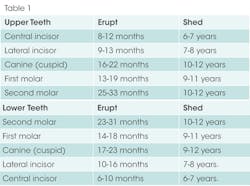So easy a four-year-old can do it!
Putting children in charge of their oral health
BY SHANNON M. NANNE, RDH
Since I was a young child, I wondered what it would be like to have children of my own. What would I name them? What would they look like? Would I have a boy or a girl? Would I have twins? Most of all, how bad was it going to hurt? Looking back at those years, something that never dawned on me was the children's oral care. Of course, being a dental hygienist for 20-plus years, you would think that would be one of my first thoughts, but it wasn't.
I'm here to prime you and get you ready, not just for those tiny teeth, but for the mouth before the teeth even erupt! You may not even see a tooth for the first six months of a child's life. Most children have a full set of 20 primary teeth by the time they are three years of age (see Table 1).
First of all, babies really like to put things in their mouths, which can lead to some scary situations. Therefore, make sure you and your entire family has up-to-date CPR training as soon as possible. This will result in good resolutions to scary situations. The things they put in their mouths may not always be the cleanest, especially if it's your second child. I'll let you moms out there think about that for a minute.
Infants naturally have Candida in their mouths and digestive tracts, which is considered normal growth. Amounts are controlled by healthy immune systems and good bacteria. Since the immune system is not fully developed in infants, the Candida in the digestive tract can overgrow and lead to an infection. Candida can also occur after a baby receives antibiotics for a bacterial infection, or with the use of steroids.
Infants can also become infected with HSV through direct skin-to-skin contact with someone who has an active lesion - something as simple as kissing your child when you have an active lesion, changing their diaper if there is a lesion on your hand, or breastfeeding with a lesion on the breast. These infections usually result in only sores on the mouth or lips of the infant.
Other lesions you may notice are canker sores. Canker sores usually heal on their own. To relieve discomfort, have your child rinse his or her mouth with salt water, or apply an over-the-counter oral gel. You may also want to give your child an analgesic such as acetaminophen or ibuprofen to relieve pain. I have used Debacterol on my kids for several years.
If you see painful blisters on the tongue or mouth along with a rash on the palms of hands or soles of feet, your child may have hand, foot, and mouth disease or herpangina, viral infections caused by the Coxsackie virus. These illnesses must run their course. Have your child drink plenty of cold fluids such as milk and water, and eat nonirritating foods. An analgesic such as acetaminophen can be given to relieve pain and reduce fever.
Even if they have no teeth, it is important to clean babies' mouths with a fluoride-free, xylitol-sweetened, safe-to-swallow, natural baby toothpaste. One good option is Happy Teeth. (gethappyteeth.com)
As our children develop teeth, how do we choose what's best for them? There are many options out there. Of course, we need to keep it fun and interesting. My kids love GUM Crayola Squeeze-A-Color Toothpaste sweetened with xylitol. Picking a toothpaste is just the beginning. How do we make brushing and flossing fun? Disposable flossers have made my life easier at bedtime. Using these makes my kids feel in charge, which in turn makes them love to floss their teeth.
Brushing? Not so much, until I started using the Sonicare For Kids toothbrush. It comes equipped with the standard two-minute timer, which is perfect for children. It also has the Kid Pacer. This includes fun sounds that play every 30 seconds to remind and encourage kids to brush the front and back parts of their upper and lower teeth. You must remember to change the head on your Sonicare every three months. Tip: Replace your brush head when the seasons change.
My five- and six-year-old kids are quite self-sufficient in the bathroom for oral care duties. Thank goodness for the help of mom and dad, along with the help of the wonderful dental products mentioned that make them feel like grown-ups and in charge of their own routines.
SHANNON NANNE, RDH, is currently the executive director of the Global Oral Cancer Forum. Shannon lectures nationally and internationally on xerostomia, oral cancer, and mysterious moles, and has published several articles. She is an ambassador with the Oral Cancer Foundation and serves as a key opinion leader for many companies. She can be reached at [email protected].
Oral cancer awareness among kids
Not only are kids in charge of oral health, but they continue to surprise me every day. I organized my first Oral Cancer Awareness Walk in September 2010 to support the Oral Cancer Foundation (oralcancerfoundation.org). My daughter at the time was the smallest walker for awareness, just 17-months-old and trucking along the path with her 2½-year-old brother. I have continued this walk for the past four years, and I'm looking forward to my fifth walk this summer in Sagamore Hills, Ohio.
We offer free oral cancer screenings, and survivors share their stories. We also have family members share stories of loved ones they have lost. It is quite powerful, hopefully will save lives, and it's beginning to bring awareness to this disease.
One person dies from oral cancer every hour of every day. Approximately 43,250 people in the U.S. will be newly diagnosed with oral cancer in 2014. This includes those cancers that occur in the mouth itself, in the very back of the mouth or the oropharynx, and on the exterior lip of the mouth. This is the fifth year in a row in which there has been an increase in the rate of occurrence of oral cancers.
There are two distinct pathways by which most people develop oral cancer. One is through the use of tobacco and alcohol, which is a long-term historic cause and problem. The other is through exposure to the HPV-16 virus (human papillomavirus version 16), a newly identified etiology, and the same one that is responsible for the vast majority of cervical cancers in women.
Worldwide, the problem is far greater, with new cases annually exceeding 640,000. With help from the Henry Schein Cares Foundation (hscaresfoundation.org), the soft launch of the Global Oral Cancer Forum took place in April at the American Academy of Oral Medicine meeting in Orlando. Clinicians, scientists, epidemiologists, activists, public health experts, and others are working hard to understand how to reduce the global oral cancer burden.
This inaugural Global Oral Cancer Forum will be showcased in New York City in September 2015 to highlight gaps and innovations in prevention, patient care, technology, and services across the oral cancer continuum. International speakers, panelists, and delegates who demonstrate passion and dedication to oral cancer will be selected from various world regions. They will convene to share the issues they face, and to learn about innovations, models, and ideas that have the potential to bring about positive change globally and help reduce the statistics. The GOCF will also be open to a limited number of registrants who will have the opportunity to be part of the forum (globaloralcancerforum.org).
If you're not comfortable with how you're screening, or you just aren't sure if you're doing it right, take the time to visit this sixstepscreening.org. There is a plethora of information to help you. During my last course in Pennsylvania, an RDH shared her story of recognizing something suspicious on her patient's tonsils. "It looked like some tonsil stones were excreting, but it was cancer." She recommended that we "really get back there and make our patients say Ah!"
Back to my surprises. In February we took our kids snowmobiling in Northern Ontario. I was a bit nervous to say the least, which led me to chew my cheeks uncontrollably. I should know better, but my nerves got the best of me. While we were sitting around the fire, my daughter asked me why I had to go on a plane that week to Chicago. I explained to her that I was speaking at a meeting in order to help educate dental professionals to help save lives. She told me that she wanted to do that too! She then asked me to open my mouth.
We laughed, but I did it to pacify her. As she looked intently into my mouth, she said, "Something isn't right here, Mommy. It looks wrong." Everyone giggled a bit and I asked her what she meant. She explained "The inside of your cheeks look bad." It was my cheek biting that she noticed. So I ask you fellow dental professionals, if a four-year-old can look inside a mouth and notice something that "looks wrong," can't you do the same?
It is so easy a four-year-old can do it! Make the choice now to get out there and save lives. I know you can do it!



